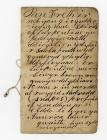Content can be downloaded for non-commercial purposes, such as for personal use or in educational resources.
For commercial purposes please contact the copyright holder directly.
Read more about the The Creative Archive Licence.
Description
Ingredients
one large cupful sucan meal
one and a half pints cold water
Method
Leave the sucan meal to steep in the cold water overnight.
Pour the mixture through a fine sieve, squeezing the meal between the hands to extract all the liquid.
Put this liquid in a saucepan and bring to the boil, stirring it continuously with a wooden stick or spoon.
When the mixture forms a thin ribbon or ‘tail’ when dropped from the tip of the stick held above the saucepan, it has boiled to the required consistency.
Pour the sucan into a bowl, rinsed beforehand with cold water and leave to set.
Serve in cold milk.
Pren-gwyn, Cardiganshire.
This dish was known as 'uwd' or 'uwd sucan' in south Cardiganshire and north Pembrokeshire, e.g. Pren-gwyn, Cardiganshire.
Brynberian, Pembrokeshire.
Sucan was associated with the hay harvest in many areas. Boiled in large quantities, it was carried out to the field in tin pans and served to the helpers at mid-day.
The local observations given in connection with testing the consistency of the sucan are noteworthy, e.g. rhaid iddo ffurfio rheffyn fel cwt cath (it must form a ribbon like a cat’s tail) (Croes-lan, Cardiganshire), or rhaid i’r sucan ddisgyn o’r pren fel cwt buwch (the sucan must drop from the stick like a cow’s tail) (Llandysul, Cardiganshire), or yr uwd yn berwi fel llygad eidion (the 'uwd' boiling like a bullock’s eye) (Brynhoffnant, Cardiganshire).
Particular attention was paid to the surface of the 'sucan' when set; a smooth surface without a single crack in it was a sure proof of the cook’s expertise at preparing the dish, but the unsuccessful cook had to face the mockery of the old belief that a cracked surface signified that she would marry a boy with an ugly face.
Sucan meal
The method of preparing this oatmeal by-product varied slightly in different areas. The following process was described by one experienced miller.
After the oats been dried and hulled, the kernels were crushed finely. This meal was then sifted to rid it of any husks or gross meal and the material that was left on the sieve (i.e. a mixture of gross meal and oat husks) was known as blawd (meal) or bwyd (food) 'sucan'.
Crug-y-bar, Carmarthenshire.






Do you have information to add to this item? Please leave a comment
Comments (0)
You must be logged in to leave a comment